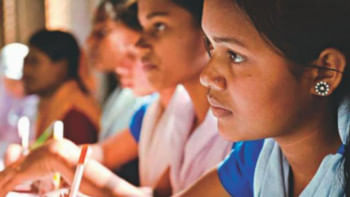An overview of the Labour Force Survey 2022

The quarterly Labour Force Survey (LFS) 2022 has been of interest to everyone, particularly to policymakers and researchers, and especially in the aftermath of the Covid-19 pandemic. There is no denying that, for evidence-based research and policy formulation in the country's labour market, it is crucial to have regular data regarding key labour market variables.
One of the most important indicators of the labour market is the participation rate. According to the LFS 2022, though there has been no notable change in the overall male participation rate over the years, the female labour force participation rate (FLFPR) experienced an increase from 36.3 percent in 2016-17 to 42 percent in 2022. This rise in participation rate, though impressive, needs to be analysed in detail as the area-wise FLFPR shows that the rate has increased in rural areas (from 38.6 percent in 2016-17 to as high as 50.9 percent in 2022), but has fallen in urban areas from 31 percent (2016-17) to 23.6 percent (2022). This fall can be partly attributed to the negative impacts of the pandemic on the urban labour market.
With the majority of Bangladeshi women working in the informal sector (91.8 percent, per the LFS 2016-17), it is likely that they have been hit hard during the pandemic. In addition, evidence shows that there has been a gradual fall in the proportionate involvement of women in the ready-made garment (RMG) sector, primarily due to increased automation. This trend has continued into recent years, affecting women's participation in non-agricultural, urban-based activities. However, it should also be examined whether part of this fall is related to increased enrolment in education.
The other side of the FLFPR is the rise in the participation rate in rural areas, especially in recent years (a 12.3 percentage-point rise between 2016-17 and 2022). This trend cannot be explained that straightforwardly. The most convincing explanation can be related to a more avid role of women as unpaid family workers in rural areas due to a gradual rise in labour migration (both internal and international) of males, with rural farm- and non-farm-based activities now being performed by an increasing number of women. Another explanation could be a gradual expansion of rural-based small and medium enterprises, which is often argued to be a sector with a significant number of female entrepreneurs.
An expansion of microcredit, for which the primary client base is rural women, might have helped women get involved in different small-scale, self-employment activities. Urban to rural reverse migration during the pandemic may be another reason behind the opposing trend of rural and urban participation rates of women. One noteworthy point here is the sector-wise distribution of employment. Though the official gender-wise disaggregated statistics is not available yet, combining information on the two sexes, agriculture-based employment shows a rising trend, and as much as 45.3 percent of the employed workforce in 2022 (40.6 percent in 2016-17) is found to be in agriculture, while 17 percent and 37.7 percent are in industry and service sectors (20.4 percent and 39 percent in 2016-17), respectively.
Despite the absence of recent gender-disaggregated data, the pattern in area-wise (urban versus rural) FLFPR of the 2022 survey as well as the trend in sector-wise FLFPR till 2016-17 (during 2016-17, 59.7 percent, 16.9 percent, and 23.5 percent women were in agriculture, industry, and service sector jobs, respectively) indicates that the female workforce is gradually becoming more concentrated in the agriculture sector, which is informal by nature and is relatively low-skilled and low-paying (or even not paying at all).
While analysing the trends and patterns of FLFPR, however, we must keep in mind that this participation includes both paid (wage employment and self-employment) and unpaid work (unpaid family work). According to the LFS 2016-17, as many as 29.1 percent of women were found to be engaged in unremunerated work, conducted under the ownership of other household members. Though we do not have corresponding recent data on the types of employment, based on a broad categorisation of employment data, more than half of the employed women (53.62 percent) are reported to be engaged in own-use production of goods, and this figure is as high as 62.6 percent for rural women.
Given that Bangladesh is going through a demographic transition, with the youth (15-29 years old) constituting 36.53 percent of the total labour force, it is important that our policy focus is on utilising this demographic dividend.
Therefore, despite an increase in the participation rate in recent years, women's involvement in the labour market is still being significantly determined by their traditional roles involving home-based production processes, rather than for marketed paid activities or profit-based entrepreneurial work.
As for men, though there has been a slight decline in both rural and urban areas, the trend and pattern of male labour force participation is consistent with the international figures. However, for the labour market, it is the rate of unemployment rather than the participation rate that is generally a matter of concern. In this regard, another crucial finding of the LFS 2022 is the fall of the unemployment rate to 3.6 percent, from 4.2 percent in 2016-17. This fall has been observed in both rural and urban areas, with the unemployment rate in the former in 2022 found to be 3.4 percent, and the rate for the latter being 4.2 percent. This trend should be analysed in light of the conventional way employment/unemployment is defined: that a person is employed if he/she has worked at least one hour in a seven-day period prior to the survey. The shortcoming of this definition in the context of Bangladesh is that a large mass of people tend to work on a temporary basis, either in return for remuneration or even without any remuneration at family farms. This type of employment is mostly temporary and ad hoc in nature, without sufficient remuneration – and an unemployment rate based on such a definition is likely to underestimate the actual scenario of unemployment in the country.
Therefore, it is crucial to have alternative definitions of unemployment (often termed as under employment) – based on hours of employment, desire for additional work, etc for future policy formulation. In addition, for effective policy formulation, in addition to hours of work, quality of work, especially the wage earned by the employed person, should be taken into consideration. Given the overwhelming degree of informality, for assessing the labour market scenario, it is also essential that the trend of informality is analysed.
While analysing the labour market data, one crucial aspect that we need to examine is that of the labour market profile of youths. Given that Bangladesh is going through a demographic transition, with the youth (15-29 years old) constituting 36.53 percent of the total labour force, it is important that our policy focus is on utilising this demographic dividend. However, according to LFS 2016-17 data, the rate of youth unemployment (10.6 percent) was higher than the national average (4.2 percent). Though we still do not have the corresponding information from the latest LFS, we need to deal with the twin challenges of youth unemployment and youth NEET (youths not in employment, education, and training) for the optimal utilisation of our favourable demographic profile.
In order to attain the country's development goals, it is crucial for there to be timely availability of data on the labour market, preferably on an annual basis. Due to a problem of applicability with the conventional data on unemployment, the Bangladesh Bureau of Statistics (BBS) should also publish data on alternative definitions of unemployment based on hours of work, weekly earnings, desire for additional work, etc, for effective policy formulation. Internal as well as international migration are an important issue, so the LFS needs to incorporate detailed information on migrants. For certain information, such as wages, hours of work, education (especially classification of tertiary education according to types of educational institutions), greater disaggregation of information is required. Besides, for certain important sectors (such as RMG), a separate section containing sector-specific relevant questions would be useful.
It is also essential to invest in skills and education while focusing more on the quality of education. With increased automation of industries and the importance of 4IR-related technologies, greater focus is needed on updating the existing curricula of training programmes, providing relevant skills-training and, more importantly, dealing with the challenges of skills mismatch. Needless to say, TVET programmes must be at the core of the strategies while dealing with the challenges facing the labour market.
In addition to policy initiatives, to properly prepare our labour force for the growing needs of the market, on the one hand it is crucial to stimulate private sector investment, while on the other hand it is imperative to provide monetary and non-monetary incentives to small-scale entrepreneurs. To remove the bottlenecks in boosting female employment, the prime focus must be on dealing with certain inherent constraints like child marriage, women's safety and security in the public sphere, along with policy interventions towards dealing with the challenges related to gender-centric norms.
Dr Sayema Haque Bidisha is professor at the Department of Economics in Dhaka University, and research director at the South Asian Network on Economic Modeling (Sanem).

 For all latest news, follow The Daily Star's Google News channel.
For all latest news, follow The Daily Star's Google News channel. 














Comments